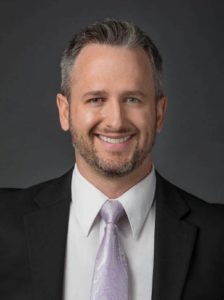By Rich Woolley, DC, MS, ATC, CMTPT/DN
Introduction
Legal disputes may require the specialized knowledge of a dry needling expert witness to assist the fact finder. The types of disputes that may require a dry needling expert witness include personal injury, medical malpractice, healthcare fraud, etc. Adverse events such as pneumothorax (collapsed lung), infection, delayed or missed diagnosis, etc., may lead to litigation.
Dry needling is a technique that has been used since the 1980s for the treatment of musculoskeletal pain.[1] It commonly involves the insertion of a solid monofilament needle into myofascial trigger points in order to reduce pain and muscle hypertonicity (tightness) and improve range of motion. The technique is called “dry” needling because no fluid is injected, as is the case with trigger point injections.
A myofascial trigger point is a “zone of intense pain in a hardened muscle band that refers (triggers) pain distantly when stimulated.”[2] Trigger points may also refer pain locally. “The mechanism that underlies development of the taut band is unknown, but altered activity of the motor endplate, or neuromuscular junction, is most likely.”[2] Clinically, symptomatic trigger points are often found in musculoskeletal injury and pain conditions.
Dry Needling: Research and Results
Research shows that trigger points can be visualized using ultrasound elastography and magnetic resonance elastography. [1, 3-5] However, the typical way to identify trigger points is via palpation. For palpation to be effective in the identification of trigger points, clinicians need to be properly trained. Proper training leads to adequate inter-rater reliability in the identification of trigger points by palpation. [1]
The effectiveness of dry needling in treating musculoskeletal pain is currently under investigation and much research still remains to be done. Unverzagt et al. concluded that “there is mounting evidence that the procedure [dry needling] can be effective at decreasing pain, improving range of motion, reducing the sensitivity of MTrPs [myofascial trigger points], and ultimately improving quality of life.”[1] A systematic review and meta-analysis published in 2017 concluded that “very low-to-moderate-quality evidence from studies in a variety of musculoskeletal conditions strongly suggest that dry needling performed by physical therapists is more effective than no treatment or sham dry needling for reducing pain, improving PPT [pressure pain threshold], and improving functional outcomes in the immediate to 12-week follow-up period.”[6]
It is important to note that it is difficult to perform a double-blinded, randomized, controlled trial due to the invasiveness of dry needling.[1] However, one well done double-blinded, randomized, placebo-controlled trial performed on subjects undergoing total knee replacement showed a significant decrease in knee pain at one month follow up in the group treated while under anesthesia prior to their operation.[7]
Clinically, I have found dry needling to be very helpful in treating a variety of musculoskeletal pain, including but not limited to: tension headaches, shoulder impingement/pain, iliotibial band syndrome, hip pain, back pain, neck pain, etc. A dry needling expert witness with extensive clinical experience and familiarity with the literature in the field may be able to assist counsel when relevant litigation occurs.
Dry Needling Licensing, Adverse Events, and Contraindications
Dry needling falls under the scope of practice of many different licensed health care professions including: medical doctors, osteopathic doctors, physical therapists (in some states), chiropractors (in some states), acupuncturists, etc. There are multiple organizations that offer training and certification in dry needling. Training requirements differ from state to state.
Adverse events may trigger litigation requiring a dry needling expert witness. Possible significant adverse events from dry needling may include: pneumothorax (collapsed lung), spinal epidural hematoma, delayed or missed diagnosis, nerve injury, infection, persistent bleeding, etc. Absolute contraindications to dry needling include but are not limited to: needle phobia, a patient who is unwilling or unable to give consent, medical emergencies, and lymphedema. Relative contraindications to dry needling include but are not limited to: immunocompromised individuals, pregnancy, vascular disease, epilepsy, psychological status, and diabetes.[1, 8]
Conclusion
Certain adverse events from dry needling may lead to significant disability or death due to improper dry needling utilization or technique. If and when litigation results, retaining a dry needling expert witness may be of value to both defendants and plaintiffs.
About the Author:
Rich Woolley, DC, MS, ATC, CMPTP/DN is an actively practicing chiropractic physician licensed in the state of Alaska since 2016. Dr. Woolley has been certified as an athletic trainer since 2012 and certified in dry needling since 2018. Dr. Woolley has used dry needling to treat numerous musculoskeletal complaints. Dr. Woolley can be contacted by cell phone: (907) 726-3668 or email: drwoolley11@gmail.com. His website is richwoolleydc.com.
References:
- Unverzagt C, Berglund K, Thomas JJ. Dry needling for myofascial trigger point pain: a clinical commentary. Int J Sports Phys Ther. 2015;10(3):402-418.
- Gerwin RD, Dommerholt J, Shah JP. An expansion of Simons’ integrated hypothesis of trigger point formation. Current Pain and Headache Reports. 2004;8(6):468-475. doi:10.1007/s11916-004-0069-x
- Chen Q, Basford J, An K-N. Ability of magnetic resonance elastography to assess taut bands. Clinical Biomechanics. 2008;23(5):623-629. doi:10.1016/j.clinbiomech.2007.12.002
- Ballyns JJ, Shah JP, Hammond J, Gebreab T, Gerber LH, Sikdar S. Objective sonographic measures for characterizing myofascial trigger points associated with cervical pain. J Ultrasound Med. 2011;30(10):1331-1340. doi:10.7863/jum.2011.30.10.1331
- Sikdar S, Shah JP, Gebreab T, et al. Novel applications of ultrasound technology to visualize and characterize myofascial trigger points and surrounding soft tissue. Arch Phys Med Rehab. 2009;90(11):1829-1838. doi:10.1016/j.apmr.2009.04.015
- Gattie E, Cleland JA, Snodgrass S. The effectiveness of trigger point dry needling for musculoskeletal conditions by physical therapists: a systematic review and meta-analysis. J Orthop Sports Phys Ther. 2017;47(3):133-149. doi:10.2519/jospt.2017.7096
- Mayoral O, Salvat I, Martín MT, et al. Efficacy of myofascial trigger point dry needling in the prevention of pain after total knee arthroplasty: a randomized, double-blinded, placebo-controlled trial. Evid Bas Complement Alternat Med. https://www.hindawi.com/journals/ecam/2013/694941/. Published March 27, 2013. Accessed July 30, 2020.
- Dommerholt J, Fernández-de-las-Peñas César. Trigger Point Dry Needling: an Evidenced and Clinical-Based Approach. Toronto: Churchill Livingstone; 2013.






